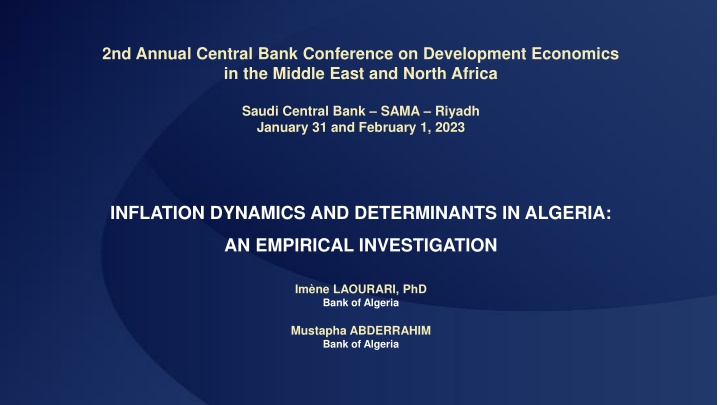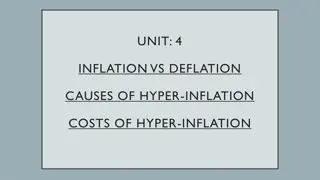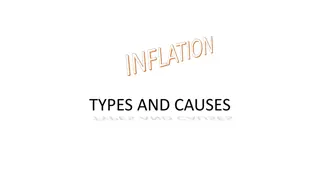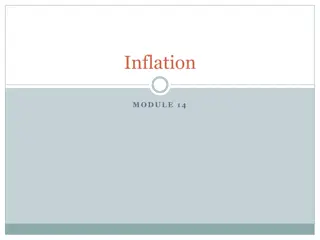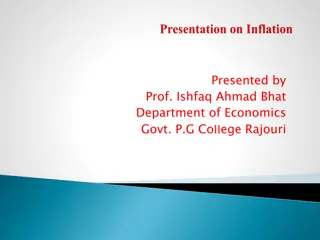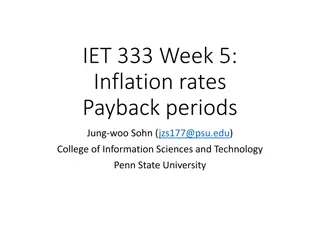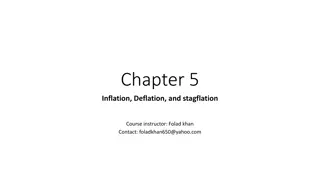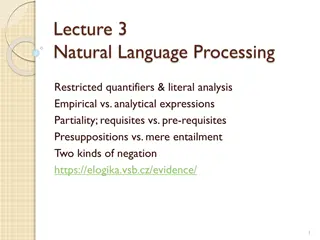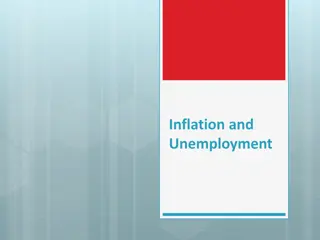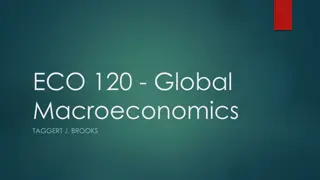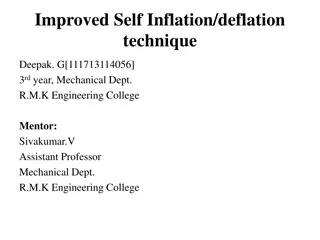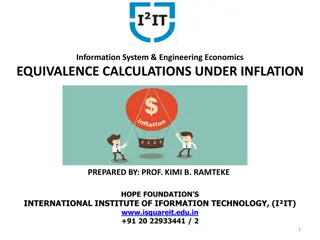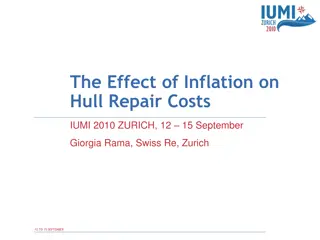Inflation Dynamics in Algeria: An Empirical Investigation
The paper investigates short and long run determinants of inflation in Algeria over a period, exploring the impact of economic volatility, geopolitical instability, and oil revenues on inflation dynamics. Through a comprehensive analysis of inflation sources, the study aims to provide insights for effective policy interventions to manage inflationary pressures in the region.
Download Presentation

Please find below an Image/Link to download the presentation.
The content on the website is provided AS IS for your information and personal use only. It may not be sold, licensed, or shared on other websites without obtaining consent from the author.If you encounter any issues during the download, it is possible that the publisher has removed the file from their server.
You are allowed to download the files provided on this website for personal or commercial use, subject to the condition that they are used lawfully. All files are the property of their respective owners.
The content on the website is provided AS IS for your information and personal use only. It may not be sold, licensed, or shared on other websites without obtaining consent from the author.
E N D
Presentation Transcript
2nd Annual Central Bank Conference on Development Economics in the Middle East and North Africa Saudi Central Bank SAMA Riyadh January 31 and February 1, 2023 INFLATION DYNAMICS AND DETERMINANTS IN ALGERIA: AN EMPIRICAL INVESTIGATION Im ne LAOURARI, PhD Bank of Algeria Mustapha ABDERRAHIM Bank of Algeria 1
OUTLINE Introduction What does the literature say? Data and empirical methodology Estimation results and discussion Conclusion 2
INTRODUCTION (1/4) The 2020 pandemic marked the beginning of an inflation hurricane , amid extreme economic volatility and geopolitical instability never seen in decades. May - September 2022 : inflation is above 5% in 88.9% of low-income countries, 91.1% of lower-middle-income countries, and 96% of upper-middle- income countries (World Bank, 2022). Main driving forces of inflation? Demand-pull inflation, cost-push inflation, increased money supply, devaluation, rising wages, policies and regulations. 3
INTRODUCTION (2/4) The sources of inflation differ across countries, and is more challenging to monitor in oil-exporting developing countries. Why? First, inflation becomes inevitable if oil revenues are not carefully invested in the real sector. Second, inflation level remained high over time in many oil- exporting developing countries despite exchange rate appreciation. 4
INTRODUCTION (3/4) Algeria: top 3 oil producers in Africa, top 10 net oil exporters in the world. In 2021, oil sector accounted for about 30% of GDP, more than 82% of exports earnings, and about 60% of total budget revenues. Algeria will benefit from a short-term surge in oil and gas prices resulting from the current pressures on the world energy markets. 5
INTRODUCTION (4/4) Even though Algeria's economy is off to a good start to 2022 after proving to be very resilient to the COVID-19 waves and their aftermath, rising inflationary tensions is unescapable. Hence, examining and identifying the country s inflation dynamics and sources is a pivotal question. Main objective of this paper is to investigate both short and long run determinants of inflation in Algeria over the 2011-2021 period using monthly data. 6
WHAT DOES THE LITERATURE SAY? (1/4) Inflation changes are often interpreted as partial adjustments to the long run (or equilibrium) of actual price levels. The relative importance of inflation determinants varies across countries and changes over time depending on: i) The use of economic resources, which determines the size of the output gap, and thus demand-side inflation; ii) Supply-side shocks for key commodities such as food and energy; 7
WHAT DOES THE LITERATURE SAY? (2/4) i) Exchange rate fluctuations which can affect general price levels due to pass-through effects; ii) The monetary policy ability to meet inflation expectations. In Algeria, recent empirical literature suggests that money supply and imported inflation are the main drivers of inflation in the country. 8
WHAT DOES THE LITERATURE SAY? (3/4) Paper Model Determinants of inflation Main findings Zaid (2013) VECM model/monthly data over the 2003 2011 period Oil prices, money supply, import price index, and the exchange rate Algerian dinar Zaid concluded that the main determinant of the country s inflation been imported inflation. of the has Si Mohammed (2016) ARDL model/data over the 1980 2012 period Import prices, oil prices, money supply, government spending, and the nominal effective exchange rate of theAlgerian dinar. Only external factors such as import prices, oil prices and nominal rate seemed to impact Algeria s inflation in the long run. exchange 9
WHAT DOES THE LITERATURE SAY? (4/4) Paper Model Determinants of inflation Main findings Souissi (2017) VECM model/data over the 2003 2016 period Import prices, money supply, government spending, and the nominal effective exchange rate of the Algerian dinar. Domestic macroeconomic policies and factors are key drivers of long-term inflation. external Mahyaoui (2019) VECM model/data over the 1990 2015 period Import prices, oil prices, GDP, money supply, spending, and effective exchange rate of the Algerian dinar. Inflation is driven by the level of import public spending and GDP. government the nominal prices, 10
DATA AND EMPIRICAL METHODOLOGY (1/3) We collected monthly data from January 2011 to December 2021 on the following variables: consumer price index (CPI), money supply (M2), nominal effective exchange rate (NEER), import price index (IPI), and public expenditure (PE). All the variables were log-transformed prior to performing our econometric analysis. Standard preliminary tests: correlation matrix, Toda-Yamamoto causality test. Checking time series stationarity:ADF, PP, and KPSS. 11
DATA AND EMPIRICAL METHODOLOGY (2/3) Examining short and long run determinants of inflation using the bounds testing or ARDL cointegration procedure developed by Pesaran et al. (2001). The long-run relationship between inflation and its determinants is estimated via this approach as follows: where the terms ?1,?2,?3,?4,?5represent the long-term coefficients, C0the constant, et the error term. 12
DATA AND EMPIRICAL METHODOLOGY (3/3) The short-run relationship between inflation and its determinants is estimated via theARDL approach as follows: where the terms , , , , , are the short-term dynamic coefficients of the model once it has converged to equilibrium. ???? 1is the error (or equilibrium) correction term derived from the long-run equilibrium relation, and is the coefficient associated with this term that represents the speed of adjustment. 13
ESTIMATION RESULTS AND DISCUSSION (1/8) CORRELATION CAUSALITY STATIONARITY The results are consistent with initial expectations : CPI-M2 (97%); CPI-IPI (86%); CPI-NEER (-94%); CPI-PE (38%). One-way relationship CPI, NEER, M2 and IPI. causal between Mixed integration: NEER are stationary in level; M2, IVI and integrated of order 1. orders CPI of theoretical and PE are No causal relationship between CPI and PE. 14
ESTIMATION RESULTS AND DISCUSSION (2/8) Short-run equation: CPI(-1) is the misalignment of the CPI from equilibrium. its long-run (-0.104) statistically The negative significant. This indicates that a misalignment of the CPI from its long-run equilibrium is corrected by 10.4 percent each period (each month in our model). In other words, a misalignment is fully corrected after 9.5 months. coefficient is and 15
ESTIMATION RESULTS AND DISCUSSION (3/8) The long-run equation takes the following form: A 1% increase in M2 leads to a 0.20% increase in inflation. Similarly, a 1% increase in IPI leads to a 0.28 percent increase in inflation. we note that the values of these coefficients are quite close, and their magnitude seems quite small. This could indicate that inflation in Algeria is not strictly a monetary phenomenon. 16
ESTIMATION RESULTS AND DISCUSSION (4/8) The effect of a depreciation of the Algerian dinar has a greater impact on inflation than the impact of an increase in import prices or in money supply. It represents the highest coefficient in terms of magnitude in our model. A 1 percent depreciation of the Algerian dinar leads to a 0.5 percent increase in inflation. Robustness check by performing the standard triad of tests, namely, an autocorrelation test (Breusch-Godfrey), a normality test (Jarque and Bera), and a heteroskedasticity test (Breusch-Pagan-Godfrey). Moreover, we implement CUSUM and CUSUMQ stability tests. 17
ESTIMATION RESULTS AND DISCUSSION (5/8) In the following, we aim to decompose the contribution of each determinant in global inflation. The decomposition method used is based on the calculation of a proxy for each variable (determinant of inflation) which depends mainly on two components: the size of its coefficient in the long-run equation, and the variation of this variable between two periods. 18
ESTIMATION RESULTS AND DISCUSSION (6/8) Contributions to inflation over the 2012 2021 period 19
ESTIMATION RESULTS AND DISCUSSION (7/8) With an average contribution of 52%, M2 ranks first. Its contribution to inflation was 85% between 2012 and 2014, then declined from 2015 (except in 2020 where its contribution reached 93%). The average contribution of IPI ranks second with a rate of 39%. Its contribution to inflation has been significantly increasing since 2015, except in 2019 where it contributed only by 4% to inflation. The NEER contributes only by 5% to inflation on average over this period. However, its contribution varies significantly from year to year. 20
ESTIMATION RESULTS AND DISCUSSION (8/8) PE contributes only marginally to inflation (an average of 4%). Nevertheless, one should bear in mind that a large proportion of public expenditure is transformed into money supply, which explains its significant contribution to inflation during the period under consideration. The main determinant of inflation in Algeria in 2021 is imported inflation, since the share of the IPI in the latter was 59%. The NEER contributed by 22% to overall inflation, while M2 contributed only by 17%. 21
CONCLUSION (1/2) This paper has sought to identify the main determinants of inflation in Algeria by analyzing monthly data from 2011 to 2021. Using an ARDL approach and controlling for a set of relevant variables, we found an empirical evidence of the existence of a cointegration relationship between inflation, M2, NEER, and IPI. We also decomposed the contribution of each determinant in global inflation over this period. 22
CONCLUSION (2/2) Our major finding is that import price index seem to be one of the main determinant of inflation, which confirms the fact that the weakness of Algeria s production and the lack of domestic product substitution make it vulnerable to world prices swings and exposes it to persistent and high levels of inflation through imports. All things being equal, the process of domestic economic diversification should be accelerated to reduce long-run inflationary pressure that stem from the import dependence. Avenues for further research: NARDL approach, demand pressures/cost- push factors/control variables (policy and exogenous shocks). 23
